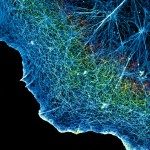Link to Pubmed [PMID] – 15617520
Cell. Microbiol. 2005 Jan;7(1):19-27
Entamoeba histolytica is the human parasite responsible of amoebiasis, during which highly motile trophozoites invade the intestinal epithelium leading to amoebic colitis, and disseminate via the blood circulation causing liver abscesses. The invasive process, central to the pathogenesis, is known to be driven by parasites motility. To investigate molecules responsible for in vivo motion, we performed a high resolution dynamic imaging analysis using two-photon laser scanning microscopy. Image analysis of the parasites during invasion of Caco-2 cell monolayers, an enterocyte-like model, and hamster liver shows that E. histolytica undergoes non-Brownian motion. However, studies of movements of parasite strains dominant negative for myosin II, a central component of the cytoskeleton, and for Gal-GalNAc lectin, a major adhesion molecule, indicate that myosin II is essential for E. histolytica intercellular motility through intestinal cell monolayers and for its motility in liver. In contrast, the Gal-GalNAc lectin exclusively triggers invasion of the liver. These observations are in agreement with emerging studies that highlight marked differences in the way that cells migrate in vitro in two dimensions versus in vivo in three dimensions. The approach that we have developed should be powerful to identify adhesive complexes required for in vivo cell migration in normal and pathogenic situations and may, thereby, lead to new therapeutic drug, for pathologies based on cell motility and adhesion.




